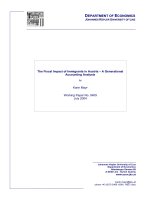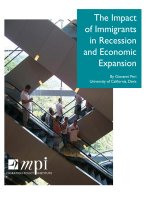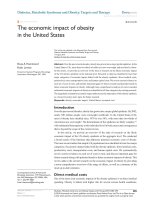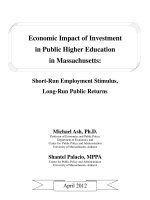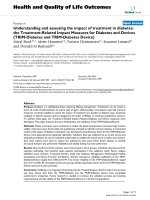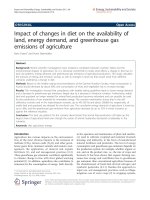Impact of online marketing of cotton on cost of marketing and involvement of middlemen in Karnataka, India
Bạn đang xem bản rút gọn của tài liệu. Xem và tải ngay bản đầy đủ của tài liệu tại đây (122.98 KB, 6 trang )
Int.J.Curr.Microbiol.App.Sci (2019) 8(1): 3086-3091
International Journal of Current Microbiology and Applied Sciences
ISSN: 2319-7706 Volume 8 Number 01 (2019)
Journal homepage:
Original Research Article
/>
Impact of Online Marketing of Cotton on Cost of Marketing and
Involvement of Middlemen in Karnataka, India
Pavitra A. Menasinkai*, Mahantesh R. Nayak and S.M. Mundinamani
University of Agricultural Sciences, Dharwad-580005, Karnataka, India
*Corresponding author
ABSTRACT
Keywords
ReMS, Online
marketing, Cost of
marketing, Benefits
of innovative
method
Article Info
Accepted:
26 December 2018
Available Online:
10 January 2019
Online marketing is an innovative method of agricultural marketing which benefits the
farmers by eliminating middlemen and also provide better price for their commodities.
Recently, a new scheme “Rashtreeya e-Market Services Private Limited (ReMS)” has been
introduced as a joint venture company with Government of Karnataka and NCDEX to
implement the agricultural marketing policy to bring transparency and improve efficiency
in the agricultural marketing system for the benefit of farmers and other market
participants. It is a modest system than the existing system of marketing to benefit both the
buyer and the seller. This system not only helps the farmer to discover their produce price
on scientific basis and get payment online but also breakdown the hold of the middlemen
in the marketing system. The present paper attempted to analyse the impact of online
marketing of cotton on price discovery, cost of marketing and involvement of middlemen
in Agriculture Market Produce Committee (APMC), Hubballi of north Karnataka. The
primary data required for the study was collected from 120 farmers, 60 each have sold
their cotton produce in online and traditional system of marketing, respectively. The
averages and percentages were computed to analyse the data. The results of the study
revealed that, the cost of marketing incurred by online farmers was not only lower (Rs. 413
per bale) than their traditional counterparts (Rs. 580 per bale) but also price realized was
higher (Rs. 8330 per bale) than their traditional farmers (Rs. 7480 per bale). In view of
online marketing, the farmers not only attracted large numbers of traders all over the
country but also avoided the involvement of many market intermediaries in the transaction
and got their payment online than their traditional counterparts. Based on the finding of the
study, it clearly indicated that, the innovative method of marketing not only reduced the
cost of marketing and involvement of market intermediaries but also realized the higher
price for their produce. To promote online method of marketing and attract more number
of farmers, efforts should be made to create awareness among the farmers regarding
benefits of the new method of marketing.
Introduction
Internet plays an important role in the
agribusiness both as a new market place and
as source of information. In recent years ecommerce has found its way in agricultural
sector in India. Electronic commerce or online
marketing comprises core business process of
buying and selling the goods, services and
information over the internet and technology
availability has increased and its access has
become easier (Dhwani, 2014). The
3086
Int.J.Curr.Microbiol.App.Sci (2019) 8(1): 3086-3091
demographic transition is also characterized
by greater willingness to use technology
among farming community. As a new trend,
farmers use internet media to contact buyers
and sellers and promote their products to
improve their farm income (Sumitha et al.,
2014). Various schemes have been
implemented by Government of India for the
welfare of farming community such as „my
produce-my price‟, e-mandi, e-choupals, etendering etc. Recently, the new scheme
Rashtreeya e-Market Services Private Limited
(ReMS) had been established as a joint
venture company with Government of
Karnataka and NCDEX spot exchange limited
having equal shareholding to implement the
agricultural marketing policy to bring an
efficiency and transparency in the agricultural
marketing system for efficient price discovery
for the benefit of farmers and other market
participants (Abhijit, 2013). This system
benefit farmers in many ways such as better
price for their produce, price discovery is
transparent, farmers and traders become
familiar with computers and online auctions,
get greater bargaining power over traders and
get better understanding about banking
(Dsouza, 2014). Online marketing has the
facility of direct electronic fund transfer from
buyer to seller. The computerized system
leads to the maintenance of mandi trading
records. It will facilitate the licensed traders
could bid online from anywhere in India and
farmers have the right to accept or reject the
price. This will lead to scientific price
discovery by the farmers themselves and
breaking the hold of middlemen. In view of
the above facts, the present paper attempted to
analyse the impact of online marketing of
cotton on price discovery, cost of marketing
and involvement f middlemen in Karnataka.
Materials and Methods
The Agriculture Produce Market Committee
(APMC), Hubballi of north Karnataka is a
leading market in the state of Karnataka for
implementation of online marketing in the
state. It has been selected purposively for the
study. The primary data required for the study
was collected from the sample farmers by
personal interview method using pre-tested
schedule. The total sample size was 120, of
which, 60 online farmers and 60 traditional
farmers. Analytical tools like descriptive
statistics and marketing efficiency measures
like benefit cost ratio was employed for the
study.
Results and Discussion
Cost incurred by farmers in marketing of
cotton
The marketing cost incurred by both
traditional and online cotton farmers was
depicted in Table 1. The results indicated that
transportation cost, bagging cost, loading and
unloading charges and commission charges of
traditional cotton farmer was
198.25,
118.25, 65.87 and 197.86 respectively to
market one bale of cotton. Likewise, for
online cotton farmers, transportation cost,
bagging cost and loading and unloading
charges were
223.92,
122.34 and
67.34respectively to market one bale of
cotton. There were no commission charges for
the online cotton farmers and there was no
grading cost for both online and traditional
cotton farmers. Hence, the total marketing
cost of both traditional and online farmers
was 580.23 and 413.60 to market one bale
of cottonrespectively.
The marketing cost of traditional and online
cotton farmers revealed that marketing cost of
online cotton farmer ( 941.58/ bale) was less
compared to traditional cotton farmers
( 1,298.37/ bale), because there was no
commission charge for online cotton farmers
where as traditional cotton farmers had
deductions from the middlemen as
3087
Int.J.Curr.Microbiol.App.Sci (2019) 8(1): 3086-3091
commission. Hence, marketing cost of online
cotton farmer was 0.28 per cent less
compared to traditional cotton farmers.
Cost and returns in production and
marketing of cotton
The cost and returns of both traditional and
online cotton farmers is presented in Table 2.
The results indicated that production cost,
marketing cost and total cost incurred by
traditional cotton farmer was 5,164.08,
580.23 and 5,744.31 per bale of cotton
respectively. Likewise, the production cost,
marketing cost and total cost incurred by
online cotton farmer were 5,198.39, 413.60
and 5,611.99 per bale of cotton respectively.
The results depicted that, production cost
incurred by online cotton farmers was 0.66
per cent more than that of traditional cotton
farmers whereas marketing cost was 0.28 per
cent less than the traditional cotton farmers.
The average output of the traditional and
online cotton farmer was 2.32 bales per acre
and 2.46 bales per acre respectively. The
average price fetched for the traditional cotton
farmer was 7,480 per bale and price fetched
for online cotton farmer was 8,330 per bale
with 11.36 per cent increase in price. Hence,
the net profit of traditional and online cotton
farmer was 1,735.69 per bale and 2,718.10
per bale of cotton showing 56.59 per cent
increase. The B: C ratio obtained for
traditional and online marketing methods was
1.30 and 1.48 respectively showing 12.16 per
cent increase in efficiency.
Perception and practices of farmers in
traditional and online marketing of cotton
The perception and practices of farmers in
traditional and online marketing of cotton is
presented in Table 3. The results indicated
that, in traditional marketing, only 7 (11.66%)
traditional farmers opined that they got
sufficient traders followed by only 2 (3.33%)
farmers involved in grading, 23 (3.33%)
farmers were exploited by the middlemen,
only 10 (16.66%) farmers got the
remunerative price for their produce, 51(85%)
farmers satisfied by the mode of payment, 39
(65%) farmers got the SMS alerts related to
price, only 27 (45%) farmers had banking
awareness, 40 (66.66%) farmers had uncleared loan with bank, 19 (36.66%) farmers
had un-cleared loan with middlemen/traders,
only 17 (28.33%) farmers had confidence to
go for online marketing.
In online marketing 52 (86.66%) farmers
opined that they got sufficient traders
followed by 42 (70%) farmers involved in
grading of their commodities, no farmer was
exploited by middlemen, 59 (98.33%) farmers
got remunerative price for their produce, 59
(98.33%) farmers got the SMS alerts related
to price, 52 (86.66%) farmers had banking
awareness, only 10 (16.66%) farmers had uncleared loan with bank, only 5 (8.3%) farmers
had un-cleared loan with middlemen/traders,
49(81.66 %) farmers had confidence to go for
online marketing which includes e-payment.
Online cotton farmers got sufficient traders
than traditional cotton farmers as many
traders would participate through online
marketing. Most of the online cotton farmers
were involved in grading than traditional
cotton farmers as grading was compulsory
operation to carry out for better price in
online marketing. But unfortunately grading
was not satisfactory due to technical problems
and lack of staff.
Traditional cotton farmers were more
exploited by middlemen (23%) due to the
unauthorized deduction, whereas no online
cotton farmer was exploited by the
middlemen. Further, online cotton farmers got
SMS alerts related to price more than
traditional cotton farmers, which was due to
3088
Int.J.Curr.Microbiol.App.Sci (2019) 8(1): 3086-3091
online farmers were registered their number
with APMC as basic step for the online
payment.
Compared to traditional cotton farmers,
online cotton farmers had more banking
awareness and its operation as it was needed
for the farmers to deal with bank for their
transactions. With respect to confidence level,
online cotton farmers were more confident
than traditional cotton farmers which depend
on age and education level of the farmers.
Table.1 Cost incurred in marketing of cotton by farmers ( / bale)
Sl No.
Particulars
Traditional farmers
Online farmers
(n=60)
(n=60)
198.25
223.92
1
Transportation cost
2
Grading cost
0.00
0.00
3
Bagging cost
118.25
122.34
4
Loading
65.87
67.34
Commission charges
197.86
0.00
Total cost
580.23
413.60
and
unloading
charge
5
Table.2 Cost and returns of cotton farmers
Sl No.
Particulars
Traditional
Online
farmers
farmers
Per cent
1
Production cost ( /bale)
5,164.08
5,198.39
0.66
2
Marketing cost ( /bale)
580.23
413.60
-0.28
3
Total cost ( /bale)
5,744.31
5,611.99
-2.30
4
Output (bale/ acre)
2.32
2.46
6.03
5
Gross return ( / bale)
7,480
8,330
11.36
7
Net return ( / bale)
1735.69
2718.01
56.59
8
B:C ratio
1.30
1.48
12.16
3089
Int.J.Curr.Microbiol.App.Sci (2019) 8(1): 3086-3091
Table.3 Perception and practices of cotton farmers in online marketing
Sl
No.
Particulars
1
Farmers get sufficient
traders
Farmers who involved in
grading.
Farmers
who
get
remunerative prices
Farmers who are satisfied
with their mode of
payment
Farmers who exploited by
the middlemen
Farmers who got SMS
registration
Farmers
who
have
banking awareness and
operation
Farmers who have uncleared loan with bank
Farmers who have uncleared
loan
with
middlemen or Trader
Farmers
who
have
confidence to go for
online marketing.
2
3
4
5
6
8
9
11
12
Traditional farmers
(n=60)
No.
Per cent
07
11.66
Online farmers
(n=60)
No.
Per cent
52
62.66
02
3.33
42
70.00
10
16.66
59
98.33
51
85.00
42
70.00
23
38.33
00
0.00
39
65.00
59
98.33
27
45.00
52
62.66
40
66.66
10
16.66
19
36.66
05
8.30
17
28.33
49
81.66
In conclusion, online marketing is an
innovative method of agricultural marketing
which benefits the farmers by eliminating
middlemen and also provide better price for
their commodities. Recently, a new scheme
“Rashtreeya e-Market Services Private
Limited (ReMS)” has been introduced as a
joint venture company with Government of
Karnataka and NCDEX to implement the
agricultural marketing policy to bring
transparency and improve efficiency in the
agricultural marketing system for the benefit
of farmers and other market participants. It is
a modest system than the existing system of
marketing to benefit both the buyer and the
seller. This system not only helps the farmer
to discover their produce price on scientific
basis and get payment online but also
breakdown the hold of the middlemen in the
marketing system. The present paper
attempted to analyse the impact of online
marketing of cotton on price discovery, cost
of marketing and involvement of middlemen
in Agriculture Market Produce Committee
(APMC), Hubballi of north Karnataka. The
primary data required for the study was
collected from 120 farmers, 60 each have sold
their cotton produce in online and traditional
system of marketing, respectively. The
averages and percentages were computed to
3090
Int.J.Curr.Microbiol.App.Sci (2019) 8(1): 3086-3091
analyse the data. The results of the study
revealed that, the cost of marketing incurred
by online farmers was not only lower (Rs. 413
per bale) than their traditional counterparts
(Rs. 580 per bale) but also price realized was
higher (Rs. 8330 per bale) than their
traditional farmers (Rs. 7480 per bale).
In view of online marketing, the farmers not
only attracted large numbers of traders all
over the country but also avoided the
involvement of many market intermediaries in
the transaction and got their payment online
than their traditional counterparts. Based on
the finding of the study, it clearly indicated
that, the innovative method of marketing not
only reduced the cost of marketing and
involvement of market intermediaries but also
realized the higher price for their produce. To
promote online method of marketing and
attract more number of farmers, efforts should
be made to create awareness among the
farmers regarding benefits of the new method
of marketing.
References
Abhijit, M., 2013, E-commerce in India - A
review.Int. J. Mktg, Manage. Res.,
42(2): 45-50.
Dhwani, R., 2014, Internet marketing over
traditional marketing, International
Journal of Software and Hardware
Research in Engineering, 2(8): 67-73.
Dsouza, D. J. and Joshi, H. G., 2014,
Development of agricultural ecommerce framework for India- A
strategic approach. Int. J. Engg. Res.
App., 4(11): 135-138
Pavitra.M., 2018, Online marketing of cotton
in APMC Hubballi- An economic
analysis. M.Sc. (Agri) Thesis, Univ.
Agric. Sci., Dharwad, Karnataka
(India).
Sumitha, T. and Kirubakaran, S., 2014, Eagriculture information management
system. International Journal of
Computer Science and Mobile
Computing, 3(5): 599-607
How to cite this article:
Pavitra A. Menasinkai, Mahantesh R. Nayak and Mundinamani, S.M. 2019. Impact of Online
Marketing of Cotton on Cost of Marketing and Involvement of Middlemen in Karnataka, India.
Int.J.Curr.Microbiol.App.Sci. 8(01): 3086-3091. doi: />
3091
